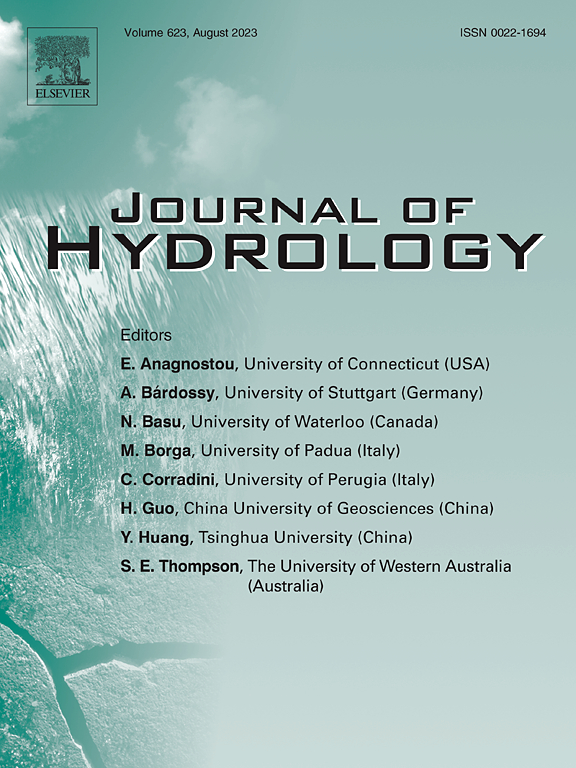利用光学和分子技术追踪玉米(Zea mays L.)生育期暴雨径流中溶解有机碳的变化
IF 6.3
1区 地球科学
Q1 ENGINEERING, CIVIL
引用次数: 0
摘要
农业径流从土壤向水生系统调动了大量的溶解有机碳(DOC),构成了土壤有机碳损失和水污染的双重威胁。降雨过程中农业径流中DOC的数量、质量和分子组成可能受到耕作方式和作物生长阶段的影响。为了验证我们的假设,我们从2020年到2023年收集了两种耕作方式(交叉垄和下坡垄)的坡耕地径流样本。我们对样品进行分析,以确定玉米各生育期(苗期、伸长期、抽雄期和成熟期)的DOC浓度和组成。该分析采用元素分析、激发发射矩阵(EEM)和傅里叶变换离子回旋共振质谱(FT-ICR MS)相结合的方法进行。结果表明,暴雨期间稻穗DOC损失通量在苗期和拔节期最高,在抽雄期最低;苗期径流中色氨酸样物质的损失量最大,占总DOC的55.13% ~ 59.82%。腐殖化指数(HIX)在0.63 ~ 0.77之间,表明径流中DOC腐殖化程度较低。DOC主要是内源的,表现出高度的降解。CHONS化合物的比例增加,在伸长期径流中木质素样物质的输出量最高。High-molecular-mass(比;450 Da)的DOC在坡耕地中所占比例最大,为44.63% ~ 48.49%。在生长阶段,高分子量的DOC在径流中积累。径流和土壤中DOC浓度是驱动径流中DOC输出的主要因素。交叉垄作是一种有效的保护性耕作方式,能显著减轻坡耕地DOC的损失。本研究确定了不同生长阶段径流中DOC数量、质量和分子组成的差异,揭示了农业径流中DOC输出的机制。研究结果为有效防治坡耕地DOC流失和缓解农业水污染提供了理论依据。本文章由计算机程序翻译,如有差异,请以英文原文为准。

Tracking dissolved organic carbon changes in agricultural runoff from rainstorms during maize (Zea mays L.) growth stages employing optical and molecular techniques
Agricultural runoff mobilizes a significant amount of dissolved organic carbon (DOC) from soils to aquatic systems, posing the dual threat of soil organic carbon loss and water pollution. The quantity, quality, and molecular composition of DOC in agricultural runoff during rainfall events may be influenced by tillage practices and crop growth stage. To test our hypotheses, we collected runoff samples from sloping croplands under two tillage practices (cross-ridge and downslope ridge) from 2020 to 2023. We analyzed the samples to determine the DOC concentrations and compositions of maize growth stages (seedling, elongation, tasseling, and maturity). This analysis was conducted using a combination of elemental analysis, excitation-emission matrix (EEM), and Fourier-transform ion cyclotron resonance mass spectrometry (FT-ICR MS). The results showed that DOC loss flux was highest at the seedling and elongation stages and lowest at the tasseling stage during rainstorms. The loss of tryptophan-like in runoff was the highest at the seedling stage, accounting for 55.13 %–59.82 % of the total DOC. The humification index (HIX) ranged from 0.63 to 0.77, indicating a low degree of DOC humification in runoff. The DOC was primarily of endogenous origin and exhibited a high degree of degradation. The proportion of CHONS compounds increased, and the export of lignin-like was the highest in the runoff at the elongation stage. High-molecular-mass (> 450 Da) DOC had the largest proportion in the sloping cropland, occupying 44.63 %–48.49 % of the total DOC. High-molecular-mass DOC accumulates in the runoff during the growth stage. Runoff and DOC concentrations in the soil are the main factors driving DOC export in runoff. Cross-ridge tillage (CR) is an effective conservation tillage method that can significantly mitigate DOC loss in sloping croplands. Our study identified the differences in DOC quantity, quality, and molecular composition in runoff at different growth stages and revealed the mechanisms driving DOC export in agricultural runoff. These findings provide a theoretical foundation for effectively preventing DOC loss in sloping croplands and mitigating agricultural water pollution.
求助全文
通过发布文献求助,成功后即可免费获取论文全文。
去求助
来源期刊

Journal of Hydrology
地学-地球科学综合
CiteScore
11.00
自引率
12.50%
发文量
1309
审稿时长
7.5 months
期刊介绍:
The Journal of Hydrology publishes original research papers and comprehensive reviews in all the subfields of the hydrological sciences including water based management and policy issues that impact on economics and society. These comprise, but are not limited to the physical, chemical, biogeochemical, stochastic and systems aspects of surface and groundwater hydrology, hydrometeorology and hydrogeology. Relevant topics incorporating the insights and methodologies of disciplines such as climatology, water resource systems, hydraulics, agrohydrology, geomorphology, soil science, instrumentation and remote sensing, civil and environmental engineering are included. Social science perspectives on hydrological problems such as resource and ecological economics, environmental sociology, psychology and behavioural science, management and policy analysis are also invited. Multi-and interdisciplinary analyses of hydrological problems are within scope. The science published in the Journal of Hydrology is relevant to catchment scales rather than exclusively to a local scale or site.
 求助内容:
求助内容: 应助结果提醒方式:
应助结果提醒方式:


